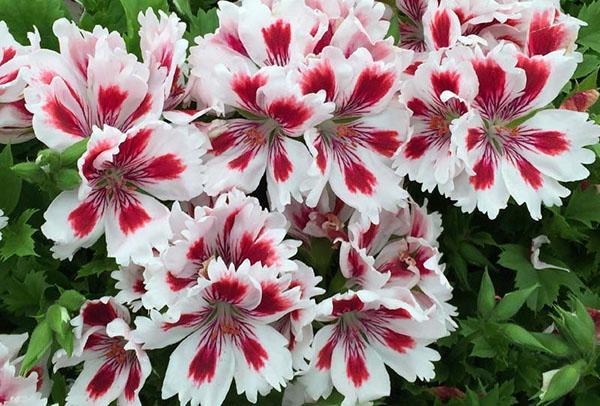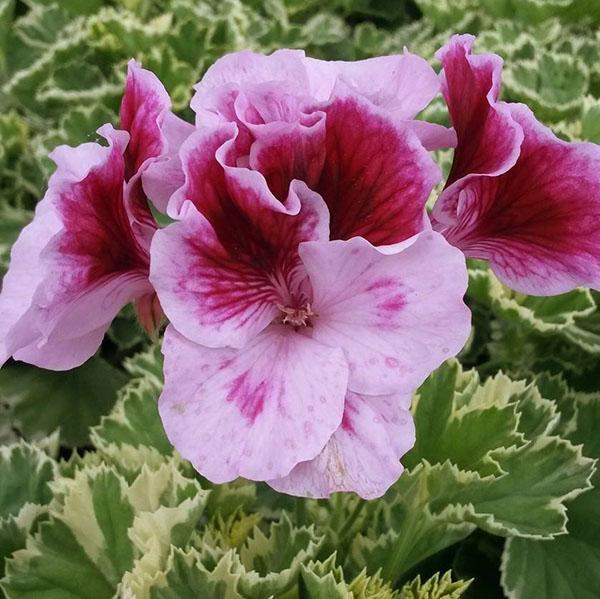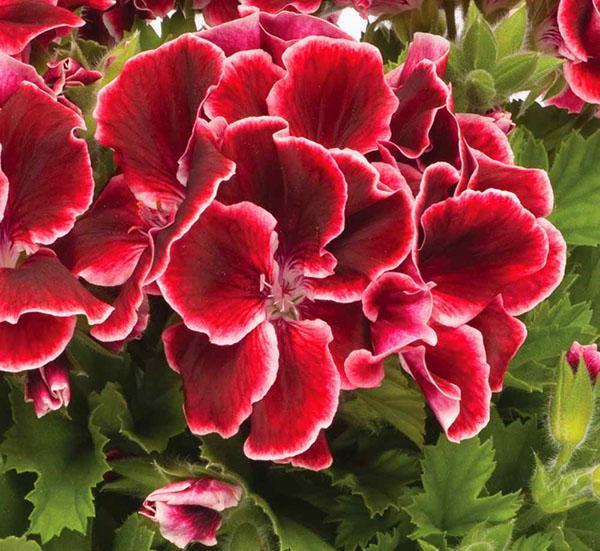How to tame a capricious beauty royal geranium?
 Among its congeners, the royal geranium stands out for the size and brightness of the flowers, as well as the exactingness of care and a somewhat capricious disposition. But the latter circumstance does not stop flower growers, and more and more lovers of decorative cultures are trying to tame the obstinate beauty.
Among its congeners, the royal geranium stands out for the size and brightness of the flowers, as well as the exactingness of care and a somewhat capricious disposition. But the latter circumstance does not stop flower growers, and more and more lovers of decorative cultures are trying to tame the obstinate beauty.
Royal geranium: features and possible difficulties

And these are not all the "pitfalls" that will have to be bypassed by a florist who wishes to decorate the collection with royal representatives of the Pelargonium genus:
- Even full adherence to agricultural techniques and caring for a pet cannot prolong flowering less than that of common zonal geraniums.
- Plants are more difficult to acclimatize if they are taken out to the veranda or garden in the summer.
- Propagation of royal geranium by cuttings, and even more so by seeds, requires more attention and time.
If a lover of indoor plants copes with the character of a bright beauty, he will be rewarded with large simple or double flowers of all shades from white to thick burgundy. At the same time, wavy, even or serrated petals of the corolla of royal pelargonium sometimes adorn stripes, spots, specks or streaks of contrasting tones. Often the richer, brighter color of the upper petals is combined with the delicate tones of the lower part of the flower, and the corollas themselves are collected in small umbrella-shaped inflorescences.
The foliage of royal geraniums has an even green color, but there are variegated varieties. On average, the flowering of plants lasts about 3-4 months. But for this, the culture requires regular watering, feeding, pruning and creating favorable conditions for growth.
Conditions for growing royal geranium
 Usually garden and indoor geraniums are clear contenders for the title of the most unpretentious and undemanding indoor plant. But their royal cousins love attention and care. If the florist is tormented by the question: “Why does the royal geranium not bloom, being next to the lush caps of bright zonal varieties?”, You should not blame the plant, but yourself. Obviously, the culture is not quite happy:
Usually garden and indoor geraniums are clear contenders for the title of the most unpretentious and undemanding indoor plant. But their royal cousins love attention and care. If the florist is tormented by the question: “Why does the royal geranium not bloom, being next to the lush caps of bright zonal varieties?”, You should not blame the plant, but yourself. Obviously, the culture is not quite happy:
- lighting;
- the selected watering mode;
- room temperature;
- the presence of a draft;
- how the pruning is done;
- soil quality or pot size.
To care for royal geraniums at home, it is important to create conditions in which the plant would be comfortable throughout the year. This type of pelargonium:
- does not tolerate overdrying an earthen coma;
- does not feel well in an overly moist dense substrate;
- it quickly stretches out and loses its decorative effect without the proper amount of light, but it is also uncomfortable under the direct beams.
Without additional shading on the south window, geranium leaves and flowers are threatened with burns and rapid wilting.The optimal location for royal geraniums is east or west. But even here in winter it is better to illuminate plants with phytolamps, extending their daylight hours to 12-14 hours. This measure will allow you to keep the compact shape of the bush without deep pruning.
 Well-being and lush flowering of geraniums is promoted by a correctly selected temperature regime:
Well-being and lush flowering of geraniums is promoted by a correctly selected temperature regime:
- In the summer months and spring, when there is an active growing season, the flowers of the royal geranium are kept at a temperature of 22 to 25 ° C.
- In winter, development slows down somewhat, so the plants need cooler air. For king geraniums to bud and prepare for the coming season, it needs a temperature of 12-16 ° C.
Plants react poorly to heat. In a room that is too warm, a green pet will slow down its growth, and some varieties stop developing altogether and refuse to form flower buds.
Caring for royal geraniums at home
 During the warmer months, all plants, including king geraniums, require more frequent and abundant watering than in winter and autumn. Do not allow water to accumulate in the pan under the pot, if this happens, the moisture is immediately drained. Irrigation water used at home to care for royal geraniums should be soft and warm enough.
During the warmer months, all plants, including king geraniums, require more frequent and abundant watering than in winter and autumn. Do not allow water to accumulate in the pan under the pot, if this happens, the moisture is immediately drained. Irrigation water used at home to care for royal geraniums should be soft and warm enough.
The soil mixture for geranium is used as a universal one. It makes no difference whether a regular zonal specimen or a "royal" is planted. For the substrate, sand, humus, peat and garden soil are taken in equal shares. Be sure to do drainage at the bottom of the pot, otherwise moisture stagnation and damage to peripheral roots cannot be avoided.
Since all geraniums do not easily tolerate transplanting, as part of caring for royal geraniums, as in the photo, at home, plants are transferred to a new pot only if the old one is already too small, and the bark system has filled its entire volume.
While the roots are braiding the soil ball, and the plant is doing well, the transplant can be replaced by adding fresh substrate right under the bush. The procedure is carried out in the spring, combined with dressing and watering.
Flowering in royal geraniums begins earlier than in related species, everything related to transplanting or pruning is important to do in the first half of February, otherwise flower buds will not have time to form on the bush.
The answer to the question: "Why does the royal geranium not bloom?" there may be an illiterate selection of containers for a flower. When choosing a pot for geraniums, they prefer small volumes. Transshipment in a spacious container threatens that the plant will abandon flowering in favor of building up green mass.
For rapid growth and friendly flowering, plants must receive complex feeding. It is easier to do this using liquid ready-made products in which the amount of nitrogen is minimal.
Royal geraniums are fed twice a month throughout the spring-summer growing season. Young seedlings are fed for the first time at the age of 6-9 months after rooting.
Propagation of royal geranium by cuttings
 The tops of shoots with several leaves obtained after pruning can be used for propagation of royal geranium by cuttings. But you need to root such planting material not in water, but in a light substrate or in a peat tablet. Before this, the cut of the cutting is treated with crushed charcoal and dried for a couple of hours, and then buried 2-3 cm into the mixture peat with sand or perlite.
The tops of shoots with several leaves obtained after pruning can be used for propagation of royal geranium by cuttings. But you need to root such planting material not in water, but in a light substrate or in a peat tablet. Before this, the cut of the cutting is treated with crushed charcoal and dried for a couple of hours, and then buried 2-3 cm into the mixture peat with sand or perlite.
It is better if each stalk receives its own soil container. This method of cultivation or the use of peat tablets will avoid mass death of sprouts due to the spread of fungal infection or rot.
After 1-2 months of keeping at a temperature of 19-23 ° C and diffused lighting, the planting material takes root, and young royal geraniums can be planted in small individual pots.
In order for the plant to form a small bush, it must be pinched when 3-4 leaves are fully opened on it. Subsequently, the growth of new shoots is limited in the same way. Active branching will not only help to form a rounded, even crown, but will also give an impetus to the formation of many buds and the lush bloom of royal begonia.
Pruning royal geraniums for lush bloom
 The benefits of pruning royal geraniums both in the lush flowering of plants and in the formation of an attractive compact bush shape. To achieve this result, you need to start work after the end of the mass flowering. For most varieties, this occurs in late summer or the first week of September. Then, in order to injure the plant less, a second wave of pruning is carried out after 1-1.5 months.
The benefits of pruning royal geraniums both in the lush flowering of plants and in the formation of an attractive compact bush shape. To achieve this result, you need to start work after the end of the mass flowering. For most varieties, this occurs in late summer or the first week of September. Then, in order to injure the plant less, a second wave of pruning is carried out after 1-1.5 months.
The autumn procedure is the most favorable and desirable, since after it the royal geranium is willingly covered with new shoots. They, in turn, are also pinched as soon as 3-5 large leaves open on the stems.
If pruning is carried out correctly and on time, then geraniums will bloom in due time, but postponing the procedure or carrying it out irregularly, you can completely remain without inflorescences.
Although even in winter conditions, with additional lighting and other requirements for caring for royal geraniums at home, you can carry out up to four pinches and get a lush blooming specimen by spring. If pruning is carried out in a lack of light, then the stems may stretch, so instead of the last January pinching, you will need to trim unsightly shoots.
Corp. pelar does not bloom.